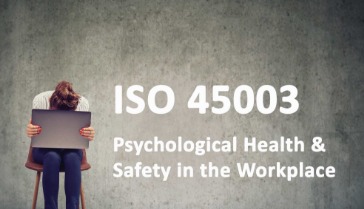ISO 45003:2021 – A Complete Guide to Psychological Health & Safety at Work
In the modern corporate world, mental health has become just as important as physical safety. Organizations today face new challenges such as employee stress, burnout, anxiety, and low engagement due to pressure, workload, and constant change. To address these issues globally, ISO introduced ISO 45003:2021, the world’s first international standard focused on psychological health and safety in the workplace. This standard acts as a guiding framework for creating safer, healthier, and more supportive work environments by identifying psychosocial risks and implementing controls.
ISO 45003:2021 complements ISO 45001, the Occupational Health & Safety Management System standard, but specifically targets mental well-being, an area that has long been overlooked in many organizations. Today, however, employees seek workplaces that not only pay attention to physical safety but also prioritize emotional and psychological security. That’s why ISO 45003 has become essential for businesses that want to succeed in the long run.
What Is ISO 45003:2021?
ISO 45003:2021 provides comprehensive guidance on how organizations can manage psychosocial risks—factors in the work environment that can negatively affect mental health, such as:
This standard doesn’t require certification, but many companies integrate it with ISO 45001 to build a fully functional Occupational Health & Psychological Safety Management System. ISO 45003 helps organizations develop policies, procedures, and practices that support mental well-being at every level.
Why ISO 45003:2021 Is Important for Modern Workplaces
Psychological health at the workplace directly impacts performance, productivity, and overall business success. Employees who feel mentally safe, valued, and supported are more committed and efficient.
Here are key reasons why organizations need ISO 45003:
1. Rising Stress & Mental Health Issues
With increasing competition, digital dependence, and demanding work schedules, mental stress has become a common problem. ISO 45003 provides controls for identifying and managing these issues effectively.
2. Reducing Absenteeism & Turnover
Organizations that fail to address mental well-being often face high absenteeism, frequent sick leaves, and high attrition rates. ISO 45003 helps reduce these issues through systematic risk management.
3. Boosting Productivity & Work Quality
A mentally healthy workforce is more productive, engaged, and committed. This directly improves the quality of work and customer satisfaction.
4. Strengthening Organizational Reputation
Employers who prioritize psychological safety are seen as responsible and employee-friendly. This enhances employer branding and helps attract top talent.
5. Supporting Remote & Hybrid Workforce
Post-pandemic, remote work has increased. ISO 45003 addresses challenges like isolation, uneven workload, remote communication gaps, and digital stress.
Key Components of ISO 45003:2021
ISO 45003 focuses on three core areas:
1. Identification of Psychosocial Hazards
Organizations must identify workplace conditions that may cause psychological harm, including:
2. Assessment & Control of Risks
Once hazards are identified, organizations must develop preventive measures such as:
-
Clear role definition
-
Fair workload distribution
-
Conflict resolution policies
-
Supportive leadership training
-
Mental health awareness programs
-
Flexible working options
-
Regular communication
3. Continuous Monitoring & Improvement
ISO 45003 requires organizations to regularly review:
This ensures long-term improvement and ongoing commitment to employee well-being.
Benefits of Implementing ISO 45003:2021
1. Improved Employee Wellness
Employees feel heard, valued, and supported. This contributes to better mental and emotional health.
2. Higher Employee Engagement
When employees feel safe and respected, they participate more actively in organizational activities and decision-making.
3. Lower Absenteeism
Reduced stress and burnout result in fewer sick leaves and more consistent performance.
4. Better Organizational Culture
ISO 45003 promotes respect, transparency, fairness, and open communication—leading to a positive workplace culture.
5. Stronger Leadership & People Management
The standard encourages leadership to adopt supportive management styles and maintain healthy relationships with employees.
6. Enhanced Customer Satisfaction
Motivated and happy employees deliver better service and performance, improving customer experience.
How ISO 45003 Supports ISO 45001
ISO 45003 is not a standalone standard. It enhances ISO 45001 by giving detailed guidelines on managing psychological hazards, which are not clearly defined in ISO 45001. Together, both standards create a holistic system for physical + mental health and safety.
Organizations already certified in ISO 45001 can easily integrate ISO 45003 guidelines without major structural changes.
Who Should Implement ISO 45003?
ISO 45003 is applicable to all organizations, including:
Any workplace where people are employed can benefit from ISO 45003.
Steps to Implement ISO 45003:2021
1. Review Current Policies
Evaluate existing health and safety measures and identify gaps.
2. Identify Psychosocial Risks
Conduct surveys, interviews, and assessments to understand employee issues.
3. Develop Action Plans
Create policies to address stress, workload, communication gaps, and leadership behavior.
4. Train Employees & Leadership
Awareness programs help employees understand the importance of mental health.
5. Monitor & Review
Track progress through regular audits and feedback mechanisms.
Conclusion
ISO 45003:2021 is a powerful tool that helps organizations create healthier, safer, and more productive workplaces by addressing mental health risks. It ensures employees work in an environment where they feel supported, respected, and empowered—leading to higher productivity, better teamwork, and long-term organizational success.
By adopting ISO 45003, organizations demonstrate a strong commitment to both physical and psychological well-being, making it essential for modern businesses that want to stay competitive and responsible.






